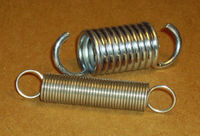Elastic potential energy
Springs are used for storing elastic potential energy
Main article: Elastic potential energy
 Elastic potential energy is the potential energy of an elastic object (for example a bow or a catapult) that is deformed under tension or compression (or stressed in formal terminology). It arises as a consequence of a force that tries to restore the object to its original shape, which is most often the electromagnetic force between the atoms and molecules that constitute the object. If the stretch is released, the energy is transformed into kinetic energy.
Elastic potential energy is the potential energy of an elastic object (for example a bow or a catapult) that is deformed under tension or compression (or stressed in formal terminology). It arises as a consequence of a force that tries to restore the object to its original shape, which is most often the electromagnetic force between the atoms and molecules that constitute the object. If the stretch is released, the energy is transformed into kinetic energy.Calculation of elastic potential energy
The elastic potential energy stored in a stretched spring can be calculated by finding the work necessary to stretch the spring a distance x from its un-stretched length:The equation is often used in calculations of positions of mechanical equilibrium. More involved calculations can be found at elastic potential energy.



No comments:
Post a Comment